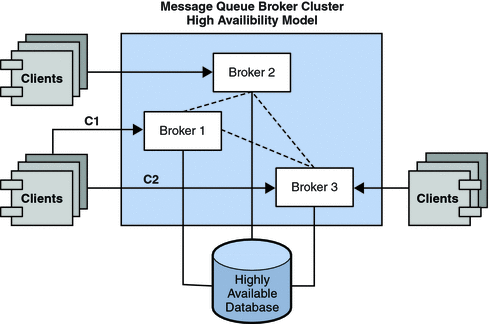High Availability Clusters
High availability clusters provide both service and data availability.
Each broker within a cluster is directly connected to all the others. Each client (message producer or consumer) has a single home broker with which it communicates directly, sending and receiving messages as if that broker were the only one in the cluster. Behind the scenes, the home broker works in concert with the other brokers to provide delivery services for all connected clients.
All brokers in a high availability cluster share a common JDBC-based persistent data store that holds dynamic state information (destinations, persistent messages, durable subscriptions, open transactions, and so on) for each broker. If a broker in the cluster fails, another broker takes over the failed broker's lock in the persistent store. Clients connected to the failed broker are reconnected to the broker that has taken over the failed broker's store. The broker that takes over the connection becomes the client's new home broker.
Figure 4–2 shows three brokers connected into a high availability cluster. The dotted line represents the cluster service. In the event that Broker 1 fails or the connection (C1) between clients at Broker 1 is broken, clients are reconnected to Broker 3 using a new connection (C2). Note that all brokers belonging to the high availability cluster are connected to the same highly available database.
Figure 4–2 High Availability Cluster

To configure a high availability cluster you set cluster configuration properties for each broker in the cluster. These specify the cluster id and the broker id in the cluster and they configure the protocol governing the failover process.
- © 2010, Oracle Corporation and/or its affiliates
